SIU Director’s Report - Case # 22-PFP-151
Warning:
This page contains graphic content that can shock, offend and upset.
Contents:
Mandate of the SIU
The Special Investigations Unit is a civilian law enforcement agency that investigates incidents involving an official where there has been death, serious injury, the discharge of a firearm at a person or an allegation of sexual assault. Under the Special Investigations Unit Act, 2019 (SIU Act), officials are defined as police officers, special constables of the Niagara Parks Commission and peace officers under the Legislative Assembly Act. The SIU’s jurisdiction covers more than 50 municipal, regional and provincial police services across Ontario.
Under the SIU Act, the Director of the SIU must determine based on the evidence gathered in an investigation whether there are reasonable grounds to believe that a criminal offence was committed. If such grounds exist, the Director has the authority to lay a criminal charge against the official. Alternatively, in cases where no reasonable grounds exist, the Director cannot lay charges. Where no charges are laid, a report of the investigation is prepared and released publicly, except in the case of reports dealing with allegations of sexual assault, in which case the SIU Director may consult with the affected person and exercise a discretion to not publicly release the report having regard to the affected person’s privacy interests.
Under the SIU Act, the Director of the SIU must determine based on the evidence gathered in an investigation whether there are reasonable grounds to believe that a criminal offence was committed. If such grounds exist, the Director has the authority to lay a criminal charge against the official. Alternatively, in cases where no reasonable grounds exist, the Director cannot lay charges. Where no charges are laid, a report of the investigation is prepared and released publicly, except in the case of reports dealing with allegations of sexual assault, in which case the SIU Director may consult with the affected person and exercise a discretion to not publicly release the report having regard to the affected person’s privacy interests.
Information Restrictions
Special Investigations Unit Act, 2019
Pursuant to section 34, certain information may not be included in this report. This information may include, but is not limited to, the following:- The name of, and any information identifying, a subject official, witness official, civilian witness or affected person.
- Information that may result in the identity of a person who reported that they were sexually assaulted being revealed in connection with the sexual assault.
- Information that, in the opinion of the SIU Director, could lead to a risk of serious harm to a person.
- Information that discloses investigative techniques or procedures.
- Information, the release of which is prohibited or restricted by law.
- Information in which a person’s privacy interest in not having the information published clearly outweighs the public interest in having the information published.
Freedom of Information and Protection of Privacy Act
Pursuant to section14 (i.e., law enforcement), certain information may not be included in this report. This information may include, but is not limited to, the following:- Confidential investigative techniques and procedures used by law enforcement agencies; and
- Information that could reasonably be expected to interfere with a law enforcement matter or an investigation undertaken with a view to a law enforcement proceeding.
- The names of persons, including civilian witnesses, and subject and witness officials;
- Location information;
- Witness statements and evidence gathered in the course of the investigation provided to the SIU in confidence; and
- Other identifiers which are likely to reveal personal information about individuals involved in the investigation.
Personal Health Information Protection Act, 2004
Pursuant to this legislation, any information related to the personal health of identifiable individuals is not included.Other proceedings, processes, and investigations
Information may also have been excluded from this report because its release could undermine the integrity of other proceedings involving the same incident, such as criminal proceedings, coroner’s inquests, other public proceedings and/or other law enforcement investigations.Mandate Engaged
Pursuant to section 15 of the SIU Act, the SIU may investigate the conduct of officials, be they police officers, special constables of the Niagara Parks Commission or peace officers under the Legislative Assembly Act, that may have resulted in death, serious injury, sexual assault or the discharge of a firearm at a person.
A person sustains a “serious injury” for purposes of the SIU’s jurisdiction if they: sustain an injury as a result of which they are admitted to hospital; suffer a fracture to the skull, or to a limb, rib or vertebra; suffer burns to a significant proportion of their body; lose any portion of their body; or, as a result of an injury, experience a loss of vision or hearing.
In addition, a “serious injury” means any other injury sustained by a person that is likely to interfere with the person’s health or comfort and is not transient or trifling in nature.
This report relates to the SIU’s investigation into the discharge of a firearm by the police at a 28-year-old man (the “Complainant”).
A person sustains a “serious injury” for purposes of the SIU’s jurisdiction if they: sustain an injury as a result of which they are admitted to hospital; suffer a fracture to the skull, or to a limb, rib or vertebra; suffer burns to a significant proportion of their body; lose any portion of their body; or, as a result of an injury, experience a loss of vision or hearing.
In addition, a “serious injury” means any other injury sustained by a person that is likely to interfere with the person’s health or comfort and is not transient or trifling in nature.
This report relates to the SIU’s investigation into the discharge of a firearm by the police at a 28-year-old man (the “Complainant”).
The Investigation
Notification of the SIU
On June 11, 2022, at 6:11 a.m., the Ontario Provincial Police (OPP) notified the SIU that a firearm had been discharged at the Complainant.
According to the OPP, on June 10, 2022, at approximately 11:00 p.m., police responded to a residence in Penetanguishene. The OPP had received information from a female that her son, the Complainant, had assaulted her. It was determined that the Complainant was in a mental health crisis. Attempts were made to arrest the Complainant. The Complainant became combative. The Emergency Response Team (ERT) attended, and negotiations continued with the Complainant. Eventually, an Anti-riot Weapon ENfield (ARWEN) was deployed within the residence. The Complainant retreated to an area of the residence where he barricaded himself. Negotiations continued during the night. At 5:25 a.m., the Complainant set the residence on fire. Police re-entered the residence to apprehend the Complainant and extinguish the fire. The Complainant was apprehended and walked to the ambulance. He was taken to the Georgian Bay General Hospital. At the time of intake, there were no reported injuries to the Complainant. The scene was held for processing. The ARWEN was secured by ERT Witness Official (WO) #2. The involved police officers were said to be Subject Official (SO) #1 and SO #2.
The Team
Date and time team dispatched: 06/11/2022 at 6:53 a.m.Date and time SIU arrived on scene: 06/11/2022 at 11:05 a.m.
Number of SIU Investigators assigned: 3
Number of SIU Forensic Investigators assigned: 2
Affected Person (aka “Complainant”):
Declined an interviewCivilian Witness (CW)
CW Interviewed The civilian witness was interviewed on July 13, 2022.
Subject Officials
SO #1 Declined interview and to provide notes, as is the subject official’s legal rightSO #2 Interviewed, but declined to submit notes, as is the subject official’s legal right.
The subject official was interviewed on July 11, 2022.
Witness Officials
WO #1 Interviewed WO #2 Interviewed
WO #3 Interviewed
WO #4 Interviewed
WO #5 Not interviewed, but notes received and reviewed
WO #6 Not interviewed, but notes received and reviewed
The witness officials were interviewed on June 15, 2022.
Evidence
The Scene
On June 11, 2022, at 11:05 a.m., a SIU forensic investigator arrived at the scene - a residence in Penetanguishene. Inside the side entrance door were stairs, which led to the basement. At the top of the stairs was a clear police shield, three ARWEN cartridges and one ARWEN projectile. Two additional ARWEN projectiles were found on the stairs. There was also evidence that a Controlled Energy Weapon (CEW) had been discharged at this location because a blast door, Anti-felon Identification Disks (AFID), and internal plastic pieces were located on the stairs.
The basement had a family room that was directly off the sliding glass doors that led to the rear yard. Just beyond the family room was a bedroom where a fire originated. The box spring and mattress at the foot of the bed were charred. A propane-type torch was on the floor at the foot of the bed.
There was one ARWEN cartridge case and one CEW probe found on the family room floor. Outside the sliding doors, the bedroom door was found. There were blood smears and a small burn area to the inside of the bedroom door. Two more ARWEN cartridge cases and two ARWEN projectiles were found outside the sliding doors. Two deployed CEW cartridge cases were located, and one probe was still attached to the wire end. Another CEW probe was also discovered at this location.
An SIU forensic investigator photographed the scene.
Physical Evidence
Physical evidence found and collected at the scene included six ARWEN cartridge cases, six ARWEN projectiles, two CEW cartridge cases, and CEW debris, wires and AFIDs.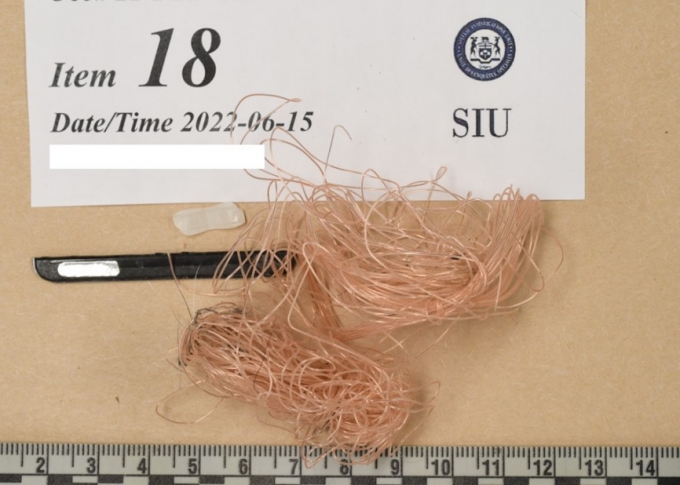
Figure 1 – CEW wires
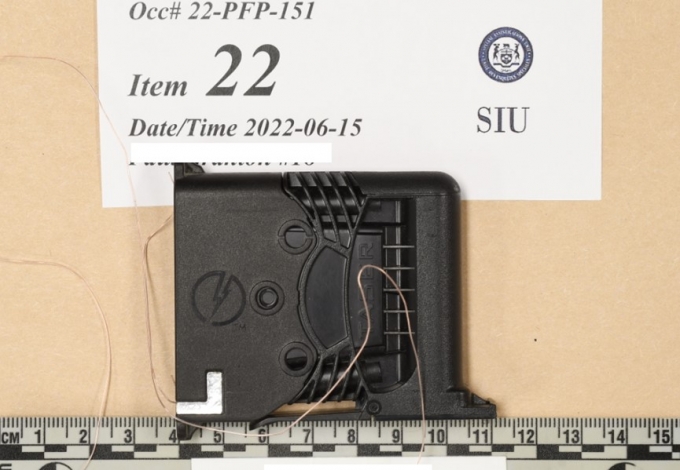
Figure 2 – CEW cartridge case
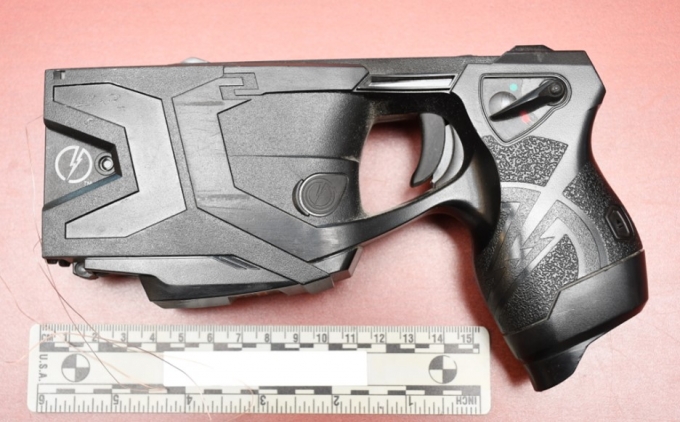
Figure 3 – CEW
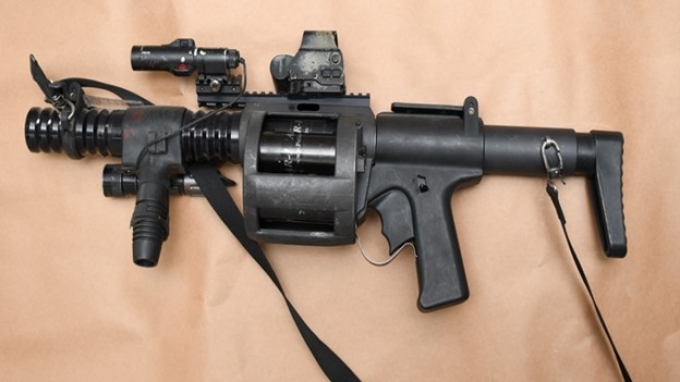
Figure 4 – ARWEN
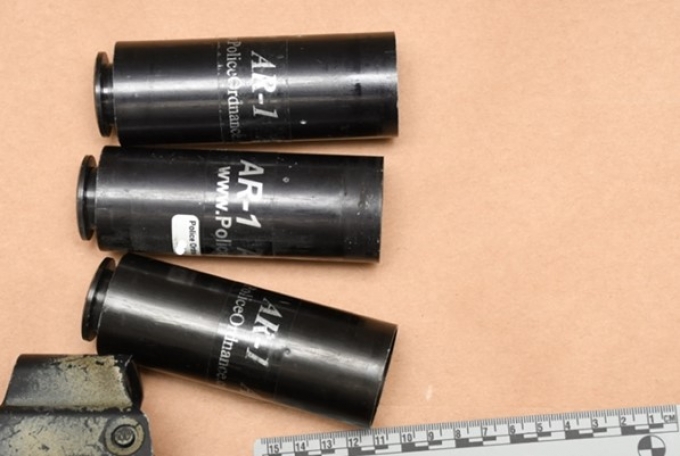
Figure 5 – ARWEN cartridges
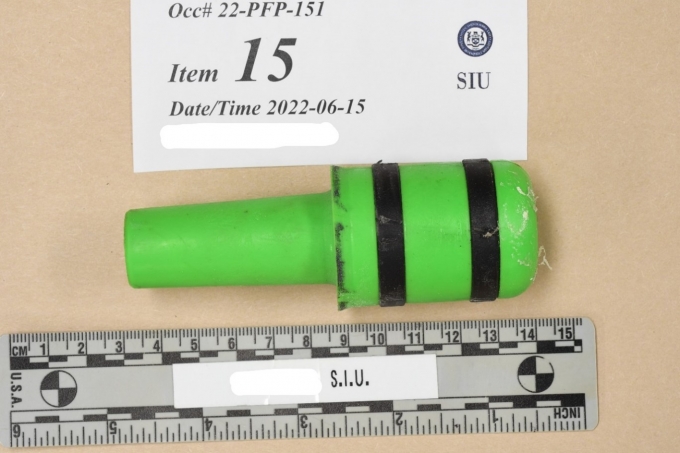
Figure 6 – ARWEN projectile
Forensic Evidence
CEWs and Downloads
On June 13, 2022, a SIU forensic investigator attended the South Georgian Bay OPP Detachment, and met with WO #1. The officer provided his CEW, which was a TASER Model X2. WO #1 provided one discharged cartridge case, which he had removed from the CEW. The CEW activity log was downloaded. The data indicated that at 1:40:13 a.m., [1] cartridge 1 was deployed for 5 seconds. At 1:40:26 a.m., cartridge 1 was re-activated for 5 seconds, at 1:40:35 a.m., cartridge 1 was re-activated for another 5 seconds, and, at 1:40:46 a.m., cartridge 1 was re-activated for another 2 seconds.
The CEW was put on safe and cartridge 1 was replaced by a new cartridge, which was placed in the same bay and therefore still named cartridge 1. The new cartridge 1 was deployed for 5 seconds at 5:42:17 a.m.
At 5:42:24 a.m., cartridge 2 was deployed for 11 seconds.
In total, WO #1’s CEW deployed three separate cartridges.
SO #1 also provided his CEW - a TASER Model X2. The CEW was not loaded with any cartridge. The CEW activity log was downloaded. The data indicated that there were no trigger pulls or discharges of any cartridge during the time the incident occurred.
A third CEW was provided, which belonged to WO #4 – a Taser Model X2. It was loaded with two cartridges - one deployed and one not deployed. The data indicated that at 2:12:09 a.m., cartridge 1 was deployed for 5 seconds. At 2:12:15 a.m., cartridge 1 was re-activated for 2 seconds. At 2:45:37 a.m., cartridge 1 was replaced with a new cartridge in the same bay and, therefore, was still named cartridge 1. At 6:10:51 a.m., the new cartridge 1 was deployed for 10 seconds.
In total, WO #4’s CEW deployed two separate cartridges.
All the deployed CEW cartridges were collected as exhibits.
Video/Audio/Photographic Evidence [2]
A copy of the OPP communications audio was obtained along with a copy of a recording in which the CW spoke to her son. A short cellular telephone video was obtained, which WO #1 recorded, depicting the inside of the bedroom as the incident progressed.
Crisis Negotiator communications recordings were also obtained from the OPP.
Cellular Telephone Video of Scene- WO #1
The SIU received four short cellular telephone videos reportedly recorded by WO #1. The first video began in a room with a patio door. The video then focused on a door, which was cracked at the top. The door was later found to be the entrance to a bedroom occupied by the Complainant. The video showed the inside of the room. The Complainant was captured sitting on the floor with his legs stretched out and his back against the right side of the door. The Complainant did not have a shirt on, and blood was smeared on the left side of his torso. The Complainant appeared to be asleep. A voice, which was apparently an OPP Crisis Negotiator, tried to converse with the Complainant.
In the second video, the Complainant moved his head to the left and opened his eyes.
In the last two videos, the Complainant was asleep. The video captured the extent to which the room had been damaged. Visible were blood stains and burn marks on the inside of the door.
Police Communications Recordings
On June 10, 2022, at 10:15 p.m., the CW called the OPP to report that her son, the Complainant, had terrorized her all night. She had just run outside across the road to a neighbour’s home. The Complainant had mental health problems and he was known to the police. The CW thought her son was suicidal, and he wanted the police to come and kill him. He was off his medication. She described her son as bi-polar and schizophrenic. She thought her son had locked himself in the house. He had no weapons and there was nobody else in the house. Her son knew that she had escaped. The CW advised that the Complainant had hurt her that day. He had hit her in the head a couple of times. Her son cornered her in the bathroom for quite some time. He was set off because he had not taken his medication and he smoked marijuana. At 10:51 p.m., WO #5 called the communications branch. He advised that he was off to the CW’s house regarding a mental health-type call. WO #5 repeated what the CW had already told the call-taker. WO #5 advised that the Complainant had said his mother was an alien who was sucking the blood out of him. The Complainant told his mother if she called the police they would come and shoot him. The Complainant did not have access to weapons. The house was all locked and was in darkness.
WO #5 called Officer #2, who was the Critical Incident Commander (CIC), and advised him of the situation. The Complainant had access to everyday weapons, tools and knives, but no other weapons.
Officer #2 asked a sergeant in the communications centre to call-out the ERT. He asked for a Crisis Negotiator team and a canine unit. Officer #2 requested Emergency Medical Services stage in the area.
The tactical radio communications, which were not time-stamped, began at 11:53 p.m. The CIC advised they had conducted a 360-full view of the premises and could see inside the residence. There was no sound from inside. Police officers near an open window advised they had made call-outs and there was no answer. The police officers could not hear the phone ring.
Entry was made via the front door, and the top floor was clear.
ERT made contact with the Complainant at top of the stairs, and they advised the Complainant was inside and not in custody.
The Complainant was said to have gone to the basement. The Complainant was inside a bedroom with the door closed and he had been struck by an ARWEN and a CEW. He did not answer the ERT call-outs.
A Crisis Negotiator was sent in.
The Complainant was said to be breathing heavily, yelling and screaming, and in total psychosis.
A telephone camera recorded a video and the Complainant was observed to breathe. There was a fire inside his bedroom.
ERT was given instructions.
Subsequent information indicated that the Complainant was in custody.
Police Crisis Negotiation Recordings
At 12:04 a.m., June 11, 2022, a Crisis Negotiator contacted his supervisor, a sergeant, and relayed information about the call. At 1:53 a.m., the CIC asked that a Crisis Negotiator contact a forensic psychiatrist for advice. At 2:11 a.m., advice was provided by the forensic psychiatrist.
At 3:11 a.m., an officer advised that a glow stick had been thrown into the room and there was no response. A cell phone camera was used, and the Complainant was heard breathing and seen lying in a fetal position. Up to that point, the Complainant had made no utterances.
At 3:44 a.m., an audio recording of the Complainant’s mother, the CW, was played for the Complainant. In the recording, the CW told her son how much she loved him, and she asked him to listen to what the Crisis Negotiator asked him to do.
Materials Obtained from Police Service
Upon request, the SIU received the following materials from the OPP between June 14, 2022, and July 28, 2022:- ARWEN Training Record- SO #1;
- ARWEN Training Record- SO #2;
- Crisis Negotiators – communications recordings;
- Event Chronology;
- Notes- WO #1;
- Notes- WO #4;
- Notes- WO #5
- Notes- WO #2;
- Notes- WO #3;
- Notes- WO #6;
- Occurrence Details and Reports;
- Communications recordings;
- Video footage from OPP cellular telephone; and
- Voice recording of message from CW to son.
Materials Obtained from Other Sources
The SIU obtained and reviewed the following records from other sources: - Ambulance Call Reports; and
- Ambulance Incident Report.
Incident Narrative
The evidence collected by the SIU, including interviews with one of the two subject officials – SO #2 – and other officers present at the time of the events in question, gives rise to the following scenario. As was his legal right, the other subject official – SO #1 – declined an interview with the SIU or to authorize the release of his notes.
The Complainant, who suffered from bipolar disorder and schizophrenia, lapsed into mental health crisis in the evening of June 10, 2022. He had been off his medication for a couple of weeks and smoking marijuana. The Complainant’s condition manifested in aggressive behaviour. When he assaulted his mother, she fled to a neighbour’s home and contacted police.
Police officers attended the Complainant’s home in Penetanguishene. From outside the residence, they called-out to the Complainant but received no response. They also tried calling and texting the Complainant but were unable to reach him. As the circumstances had developed into a potentially barricaded person situation, an ERT team and trained negotiators were deployed to the scene.
ERT officers, including SO #2 and SO #1, began arriving at the residence at about midnight. They surrounded the home and attempted to make contact with the Complainant without success. At about 1:30 a.m., concerned for the Complainant’s well-being given his state of mind, the CIC decided to have ERT enter the home.
SO #2 and SO #1, together with WO #1, WO #4, and WO #3, entered the residence. Not finding anyone on the main floor, the team re-formed at the top of a set of stairs leading to the basement. As the team was preparing to descend, the Complainant appeared at the bottom of the stairs and started to make his way up. SO #2 was at the front of the stack of officers with a shield, a step or two down the stairway. The Complainant made contact with the officer, punching and kicking at the shield. The officer reacted by kicking the Complainant as other officers fired their weapons. SO #1, from a position behind SO #2, fired three rounds from his ARWEN, as WO #1 discharged his CEW. The CEW deployment appeared to incapacitate the Complainant, who fell face first down the stairs. Once at the bottom of the stairs, the Complainant picked himself up and disappeared into the basement.
SO #1 provided SO #2 his ARWEN, and WO #4 exchanged CEWs with WO #1, after which the team made their way into the basement family room. The Complainant had retreated into a bedroom off of the family room. Within moments of the officers’ arrival, the Complainant opened the bedroom door and lobbed a paintball metal canister at WO #1. SO #2 reacted by firing the ARWEN in his possession – a single round that struck the Complainant in the abdomen. WO #1 also reacted, discharging the CEW in his possession at the Complainant. The Complainant fell and then slammed the bedroom door shut. The stand-off continued.
From outside the bedroom door, WO #1 attempted to communicate with the Complainant, assuring him the officers were there to help. Trained negotiators also attempted to open lines of communication with the Complainant. Those efforts were to no avail. At about 5:00 a.m., again concerned for the Complainant’s safety, the CIC decided the ERT should force entry into the bedroom. That decision was put on hold when the Complainant was heard from the bedroom to indicate that he needed some time but would soon exit.
At about 5:30 a.m., ERT members observed fire in the bedroom through a bedroom window. The Complainant had set fire to a chair. ERT officers breached the bedroom door and entered with fire extinguishers which they used to attempt to put out the fire. They could not immediately locate the Complainant and had to vacate the room because of the smoke. Firefighters subsequently entered the room and also exited without having seen the Complainant.
With the officers and firefighters in the family room, the Complainant emerged from the bedroom, charged at the firefighters, and ran in the direction of the open patio doors, which opened into the backyard. WO #1 and WO #4 fired their CEWs at about the same time as SO #2, from a position outside the patio doors, discharged his ARWEN twice at the Complainant. Both rounds struck the Complainant. The Complainant fell and was approached by officers who handcuffed him without further incident.
The Complainant was transported to hospital following his arrest and reportedly diagnosed with a fractured right elbow.
The Complainant, who suffered from bipolar disorder and schizophrenia, lapsed into mental health crisis in the evening of June 10, 2022. He had been off his medication for a couple of weeks and smoking marijuana. The Complainant’s condition manifested in aggressive behaviour. When he assaulted his mother, she fled to a neighbour’s home and contacted police.
Police officers attended the Complainant’s home in Penetanguishene. From outside the residence, they called-out to the Complainant but received no response. They also tried calling and texting the Complainant but were unable to reach him. As the circumstances had developed into a potentially barricaded person situation, an ERT team and trained negotiators were deployed to the scene.
ERT officers, including SO #2 and SO #1, began arriving at the residence at about midnight. They surrounded the home and attempted to make contact with the Complainant without success. At about 1:30 a.m., concerned for the Complainant’s well-being given his state of mind, the CIC decided to have ERT enter the home.
SO #2 and SO #1, together with WO #1, WO #4, and WO #3, entered the residence. Not finding anyone on the main floor, the team re-formed at the top of a set of stairs leading to the basement. As the team was preparing to descend, the Complainant appeared at the bottom of the stairs and started to make his way up. SO #2 was at the front of the stack of officers with a shield, a step or two down the stairway. The Complainant made contact with the officer, punching and kicking at the shield. The officer reacted by kicking the Complainant as other officers fired their weapons. SO #1, from a position behind SO #2, fired three rounds from his ARWEN, as WO #1 discharged his CEW. The CEW deployment appeared to incapacitate the Complainant, who fell face first down the stairs. Once at the bottom of the stairs, the Complainant picked himself up and disappeared into the basement.
SO #1 provided SO #2 his ARWEN, and WO #4 exchanged CEWs with WO #1, after which the team made their way into the basement family room. The Complainant had retreated into a bedroom off of the family room. Within moments of the officers’ arrival, the Complainant opened the bedroom door and lobbed a paintball metal canister at WO #1. SO #2 reacted by firing the ARWEN in his possession – a single round that struck the Complainant in the abdomen. WO #1 also reacted, discharging the CEW in his possession at the Complainant. The Complainant fell and then slammed the bedroom door shut. The stand-off continued.
From outside the bedroom door, WO #1 attempted to communicate with the Complainant, assuring him the officers were there to help. Trained negotiators also attempted to open lines of communication with the Complainant. Those efforts were to no avail. At about 5:00 a.m., again concerned for the Complainant’s safety, the CIC decided the ERT should force entry into the bedroom. That decision was put on hold when the Complainant was heard from the bedroom to indicate that he needed some time but would soon exit.
At about 5:30 a.m., ERT members observed fire in the bedroom through a bedroom window. The Complainant had set fire to a chair. ERT officers breached the bedroom door and entered with fire extinguishers which they used to attempt to put out the fire. They could not immediately locate the Complainant and had to vacate the room because of the smoke. Firefighters subsequently entered the room and also exited without having seen the Complainant.
With the officers and firefighters in the family room, the Complainant emerged from the bedroom, charged at the firefighters, and ran in the direction of the open patio doors, which opened into the backyard. WO #1 and WO #4 fired their CEWs at about the same time as SO #2, from a position outside the patio doors, discharged his ARWEN twice at the Complainant. Both rounds struck the Complainant. The Complainant fell and was approached by officers who handcuffed him without further incident.
The Complainant was transported to hospital following his arrest and reportedly diagnosed with a fractured right elbow.
Relevant Legislation
Section 25(1), Criminal Code -- Protection of persons acting under authority
25 (1) Every one who is required or authorized by law to do anything in the administration or enforcement of the law
(a) as a private person,(b) as a peace officer or public officer,(c) in aid of a peace officer or public officer, or(d) by virtue of his office,
is, if he acts on reasonable grounds, justified in doing what he is required or authorized to do and in using as much force as is necessary for that purpose.
Section 17, Mental Health Act -- Action by police officer
17 Where a police officer has reasonable and probable grounds to believe that a person is acting or has acted in a disorderly manner and has reasonable cause to believe that the person,
(a) has threatened or attempted or is threatening or attempting to cause bodily harm to himself or herself;(b) has behaved or is behaving violently towards another person or has caused or is causing another person to fear bodily harm from him or her; or(c) has shown or is showing a lack of competence to care for himself or herself,
and in addition the police officer is of the opinion that the person is apparently suffering from mental disorder of a nature or quality that likely will result in,
(d) serious bodily harm to the person;(e) serious bodily harm to another person; or(f) serious physical impairment of the person,
and that it would be dangerous to proceed under section 16, the police officer may take the person in custody to an appropriate place for examination by a physician.
Analysis and Director's Decision
On June 11, 2022, the Complainant was the subject of multiple ARWEN shots fired by OPP officers. The officers who discharged their weapons – SO #1 and SO #2 – were identified as the subject officials in the ensuing SIU investigation. The investigation is now concluded. On my assessment of the evidence, there are no reasonable grounds to believe that either subject official committed a criminal offence in connection with the incident.
Pursuant to section 25(1) of the Criminal Code, police officers are immune from criminal liability for force used in the course of their duties provided such force was reasonably necessary in the execution of an act that they were required or authorized to do by law.
SO #2 and SO #1 were within their rights in seeking to take the Complainant into custody. In light of the Complainant’s state of mind at the time, and the violence he had exhibited to his mother, he was subject to apprehension under section 17 of the Mental Health Act.
With respect to the force used in aid of the Complainant’s arrest, in particular, the ARWEN discharges by SO #2 and SO #1, I am satisfied that it was legally justified. The decisions to first enter the home and, then, the bedroom, seem to have been reasonably taken. Negotiations had been given a fair chance of success and there was genuine concern that the Complainant might resort to self-harm. In light of the Complainant’s violent disposition prior to their arrival, the ERT officers had cause to have their weapons at the ready inside the home in the event they were necessary. Those fears materialized when the Complainant charged up the stairs and attacked SO #2, prompting SO #1 and WO #1 to fire their ARWEN and CEW, respectively. The use of these less-lethal weapons to subdue the Complainant would not appear disproportionate in the circumstances; the officers were confined in a small space at the top of a stairwell limiting their ability to engage with the Complainant hand-to-hand. The same may generally be said of the further use of these weapons by SO #2, WO #1 and WO #4. In each case, they were a reaction to violence or threats of violence directed at the police or firefighters, and intended to deter the Complainant’s aggression without the infliction of serious injury.
In the result, while I accept that the Complainant’s fractured arm was incurred at some point in his interaction with the police, whether the result of his fall down the stairs or being struck by one or more ARWEN rounds, or some combination of the two, I am not satisfied that it is attributable to any unlawful conduct on the part of the involved officers. Accordingly, there is no basis for proceeding with criminal charges in this case. The file is closed.
Date: October 7, 2022
Electronically approved by
Joseph Martino
Director
Special Investigations Unit
Pursuant to section 25(1) of the Criminal Code, police officers are immune from criminal liability for force used in the course of their duties provided such force was reasonably necessary in the execution of an act that they were required or authorized to do by law.
SO #2 and SO #1 were within their rights in seeking to take the Complainant into custody. In light of the Complainant’s state of mind at the time, and the violence he had exhibited to his mother, he was subject to apprehension under section 17 of the Mental Health Act.
With respect to the force used in aid of the Complainant’s arrest, in particular, the ARWEN discharges by SO #2 and SO #1, I am satisfied that it was legally justified. The decisions to first enter the home and, then, the bedroom, seem to have been reasonably taken. Negotiations had been given a fair chance of success and there was genuine concern that the Complainant might resort to self-harm. In light of the Complainant’s violent disposition prior to their arrival, the ERT officers had cause to have their weapons at the ready inside the home in the event they were necessary. Those fears materialized when the Complainant charged up the stairs and attacked SO #2, prompting SO #1 and WO #1 to fire their ARWEN and CEW, respectively. The use of these less-lethal weapons to subdue the Complainant would not appear disproportionate in the circumstances; the officers were confined in a small space at the top of a stairwell limiting their ability to engage with the Complainant hand-to-hand. The same may generally be said of the further use of these weapons by SO #2, WO #1 and WO #4. In each case, they were a reaction to violence or threats of violence directed at the police or firefighters, and intended to deter the Complainant’s aggression without the infliction of serious injury.
In the result, while I accept that the Complainant’s fractured arm was incurred at some point in his interaction with the police, whether the result of his fall down the stairs or being struck by one or more ARWEN rounds, or some combination of the two, I am not satisfied that it is attributable to any unlawful conduct on the part of the involved officers. Accordingly, there is no basis for proceeding with criminal charges in this case. The file is closed.
Date: October 7, 2022
Electronically approved by
Joseph Martino
Director
Special Investigations Unit
Endnotes
- 1) The CEW times were derived from the internal clocks of the weapons, which are not necessarily synchronous with actual time or between weapons. [Back to text]
- 2) The following records contain sensitive personal information and are not being released pursuant to section 34(2) of the Special Investigations Unit Act, 2019. The material portions of the records are summarized below. [Back to text]
Note:
The signed English original report is authoritative, and any discrepancy between that report and the French and English online versions should be resolved in favour of the original English report.
